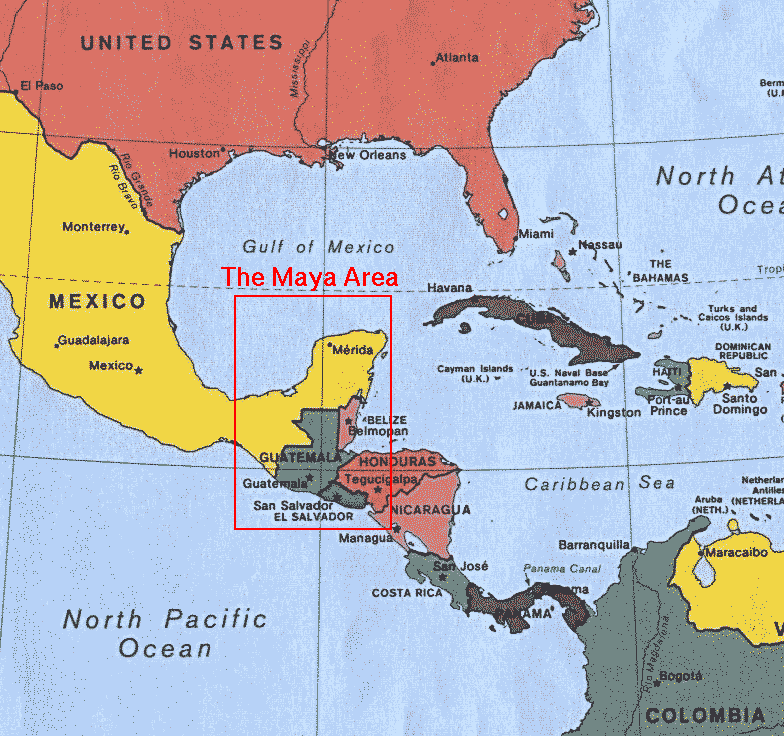Mayan Culture & Human Sacrifice
ANTH 452
Abstract
Human sacrifice is a sacred ritual traced back to the pre-Columbian era when the blood of human disciples was offered to gods and goddesses. This sacrifice took forms in auto-sacrifice, self-mutilation, and sacrifice leading to death of those in lower-status, such as prisoners of war. Those who participated in blood rituals and sacrifice believed blood was an important offering of nourishment, which meant the sacrifice of human life was the ultimate giving of blood. Human life was given through decapitation, heart removal, arrow sacrifice, and other methods. This history is displayed through human remains and artwork revealing these rituals. The exchange of vital essences of the body is thought to be the utmost form of communication with the sacred gods and goddesses.
Mayan Culture: Pre-Columbian Era

Background
The Maya covers southeastern Mexico, Guatemala, Belize, and parts of Honduras and El Salvador. They were a Mesoamerican civilization. The earliest settlements date back to 1800 B.C.. They were advanced in their culture with agriculture and pyramid-building (History.com 2009).
Mayan Beliefs
Mayan culture encouraged forms of sacrifice through blood, which was seen as nourishment for the gods and goddesses. The Mayans believed in an afterlife, and in order to show their appreciation for that, they carried out human sacrifices to pay their respects to their gods and goddesses (Zaccagnini 2003).


Methods of Sacrifice
Several methods were used when it came to human sacrifice, and not all methods resulted in death. Auto sacrificing, also known as blood-letting, and self-mutilation were forms that did not need to result in death. It was most common to draw blood from the ears, tongue, or penis. Sexual organs were believed to be more sacred, and drawing blood from these organs was speculated to be connected with fertility powers. Methods that resulted in death included decapitation, heart removal, being beaten, scalped, burnt or disemboweled. These methods are verified through ancient artwork and skeletal remains (Tiesler & Cucina 2007).
Mayan Gods and Goddesses
Missing Deities

Mayan history included more than 250 reported deities. Today, there is lacking information on these gods and goddesses due to the mass burning of their books that took place in 1562 from Catholic priests. One religious text we rely on for information is known as "Popol Vuh." Some gods and goddesses are still missing, and others are missing their definitions as it came from Mayan culture (Mark 2023).
Myths and Rituals
Myths and rituals within the culture of Maya had an interdependent relationship with one another. Sacrificial rituals took place in order to fulfill the symbolic meaning behind the gods and goddesses. These rituals are noted from the Classic Period (AD 250-900) through the 17th century during the final stages of the Spanish conquest (Joralemon, 1974). Rituals play an important part within this history as it contributes to the community, beliefs, and overall meaning of life to the Mayans (Sims et al. 2011).


Pitz Mythology
One ritual alongside human sacrifice was known as the ballgame Pitz. It represented the transition between life and death. This had a large religious, symbolic, and entertaining impact. A large rubber ball was used to try and score through stone hoops without using one's hands. Following this game, a sacrifice was often made. It was most often a Mayan team and a team of captives that would participate. If the captives lost, they would be offered to the gods. This traces back to the myth of the Hero Twins (Zaccagnini 2003).
Important Gods and Deities
The Mayans praised multiple gods. One of the most important ones being Chaac, the God of Rain, the God of Storms was Kukulkan, Tepeu was the God of Heaven, Ixchel was the God of the Moon, and Buluc-Chabtan was the deity of war and human sacrifice (Mark 2023).


Rites of Passage
The rite of passage is an important belief when it comes to human sacrifice. It is believed that gods and goddesses can be paid respects through blood. These ceremonies have an obvious rite of separation when Mayans mark the separation from their previous viewing from the point of their gods and goddesses (Gennep et al. 2019). This difference can be seen when auto sacrificing is completed by those higher in society than those who are sacrificed completely, who are often captives.
Bibliography
Gennep, Arnold van, Monika B. Vizedom, Gabrielle L. Caffee, and David I. Kertzer. The rites of passage. Chicago: University of Chicago Press, 2019.
History.com, ed. “Mayan Civilization: Calendar, Pyramids & Ruins| History.” History.com, October 29, 2009. https://www.history.com/topics/ancient-americas/maya.
Joralemon, D. Ritual blood-sacrifice among the ancient Maya: Part I, 1974. https://www.precolumbia.org/pari/publications/RT02/Joralemon1974-OCR.pdf.
Mark, Joshua J. “The Mayan Pantheon: The Many Gods of the Maya.” World History Encyclopedia, November 21, 2023. https://www.worldhistory.org/article/415/the-mayan-pantheon-the-many-gods-of-the-maya/.
Sims, Martha C., Martine Stephens, Christopher Schroeder, and Sims Martha -- Stephens. "Ritual," in Living folklore, 2nd edition: An introduction to the study of people and their traditions, 98-129. University Press of Colorado, 2011.
Tiesler, Vera, and Andrea Cucina. New Perspectives on human sacrifice and ritual body treatments in ancient Maya society. Springer, 2007.
Zaccagnini, Jessica. “Maya Ritual and Myth: Human Sacrifice in the Context of the Ballgame ...” Honors Theses, December 2003. https://opensiuc.lib.siu.edu/cgi/viewcontent.cgi?article=1335&context=uhp_theses.